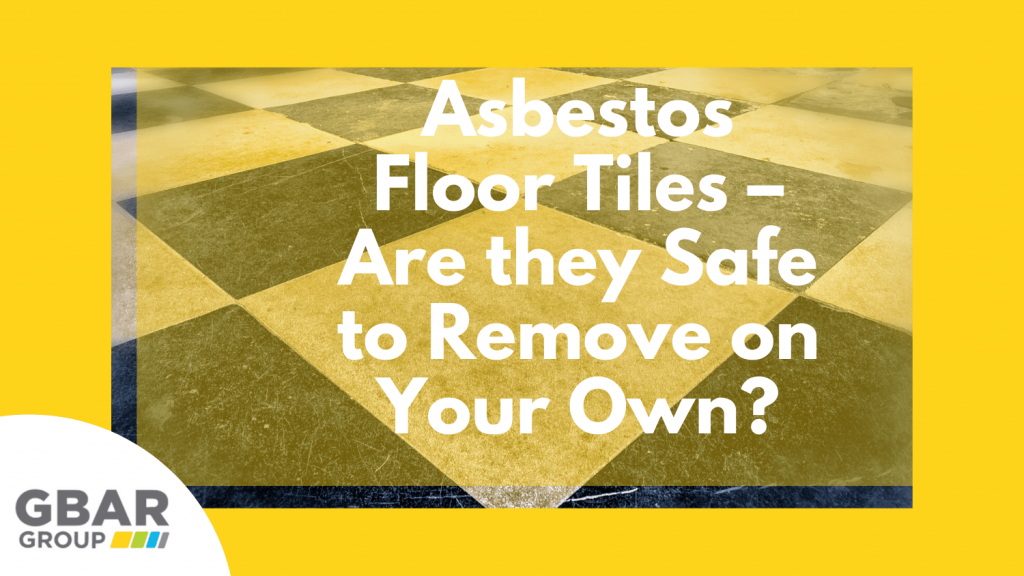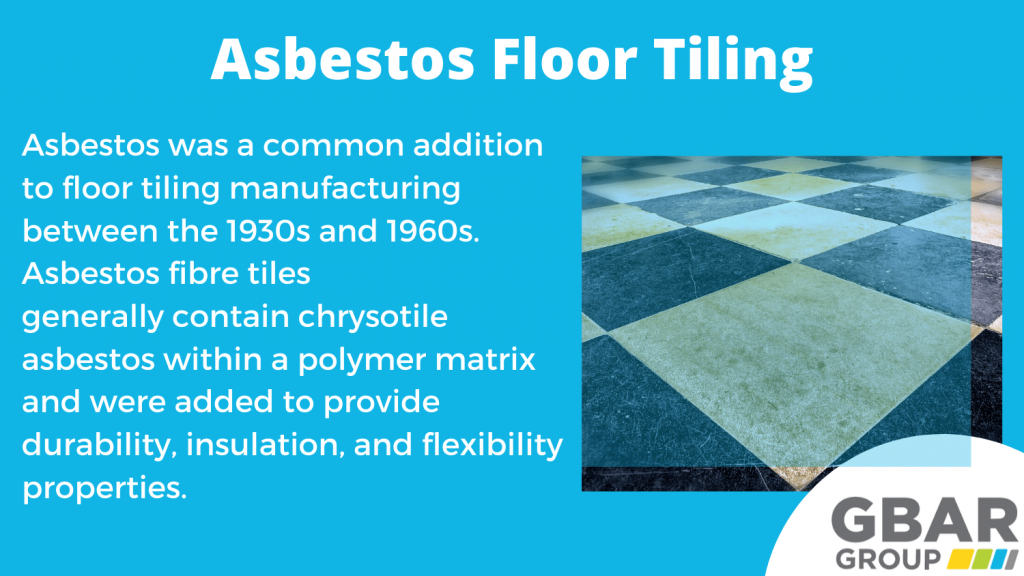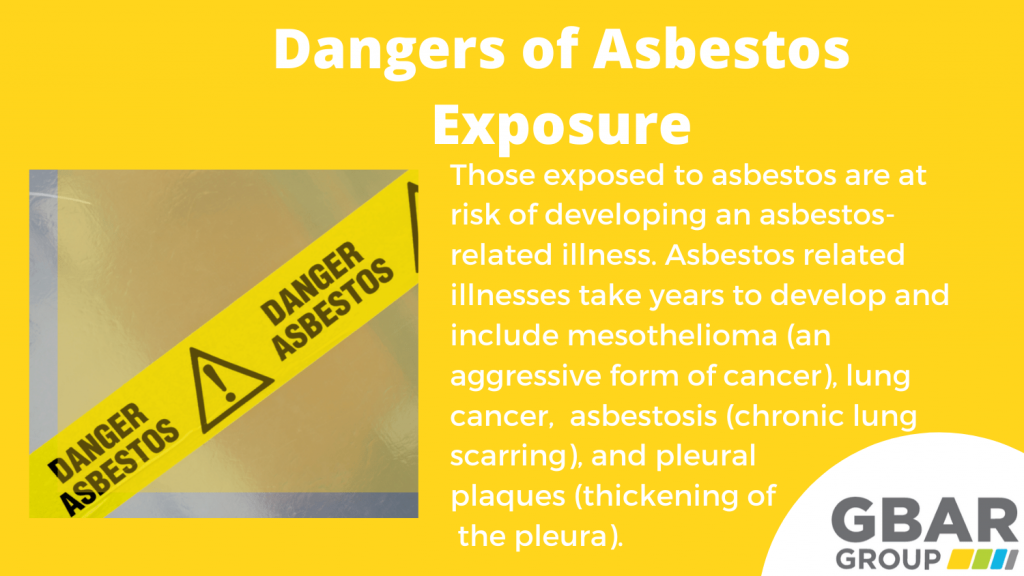
Asbestos floor tiles are typically the least harmful asbestos-containing household products. Made from vinyl, the asbestos in floor tiles is generally still well bonded, the fibres not posing a threat until disturbed. So, while asbestos floor tiling does not render the same risk as loose-fill asbestos insulation, asbestos floor tiles need to be handled with care.
Many houses built before 1990 may contain asbestos floor tiling. If you’re an owner of an older home, you’re probably going to face asbestos in one form or another. Whether you’re about to undertake demolition, renovations, or engage in some DIY house projects, it’s essential first to consider the materials your house was initially constructed with before going ahead.
Most asbestos-containing materials in older homes will not pose a threat until they become damaged or disturbed. This also applies to asbestos floor tiling. If asbestos-containing materials are kept in good condition, they are relatively harmless. However, as soon as you notice suspected asbestos tiles damaged, worn, cracked or broken, it’s vital to manage the materials before asbestos becomes a hazard.
While asbestos floor tiles are relatively harmless when intact, attempting to disturb them or rip them out is not safe. This article will discuss asbestos floor tiles and the risks of DIY asbestos floor tile removal.
What is Asbestos Floor Tiling?
Asbestos floor tiling is typically vinyl flooring installed between the 1930s and the 1990s. Before the restrictions were placed in Australia, asbestos was a common addition to floor tiling materials. Asbestos was a favourite for its insulation properties and its abilities to resist fire. Asbestos fibre tiles generally contain chrysotile asbestos within a polymer matrix – mixing in asbestos for flooring materials allowed the finished product to benefit from the mineral’s properties.

In addition to the tiles themselves, the layer of adhesive below asbestos flooring can also contain asbestos. Asbestos was commonly added to adhesives and glues to help strengthen the mastic when bonding two materials together. Often you will find asbestos-containing adhesive underneath asbestos floor tiling.
Asbestos floor tiling is a bonded material, so in theory, it is non-friable. Non-friable means that asbestos floor tiling is considered to be less harmful than other materials unless it is releasing dust or fibres into the air where they can be inhaled.
When Were Asbestos Tiles Used?
Asbestos, a heat resistant fibrous silicate mineral, was a common element in household construction materials up until the 1990s. Asbestos was used in just about every product for increased durability and insulation properties. Commonly found in construction materials for surfaces such as walls and floor tiles, many houses that were built before 1990 contain asbestos floor or ceiling tiles.
Between the 1930s and 1960 asbestos was a popular material used in floor tiles. The tiles during this period were generally made in 9-inch squares and were a bit thicker than most modern vinyl floor tiling. Asbestos was particularly popular for lining and tiles as it made the tiles flexible, durable, and easy to lay.
Asbestos Floor Tiles Dangers
Asbestos is a toxic mineral that was heavily used in Australia between the 1930s and 1990s. Asbestos was added to the manufacturing of floor tiles for insulation and heat resistance properties and flooring with asbestos is classed as a non-friable asbestos-containing material. Once mixed into asbestos tiling materials, the fibres become bonded, sealed in, and do not pose the same threat as friable asbestos materials.
Asbestos floor tiles will not release toxic fibres and pose a health risk unless the materials are disturbed. Asbestos floor tiles become dangerous during the process of demolition, removal, or deterioration from wear and tear.
Sanding, drilling, sawing, or ripping the tiles out can easily release the asbestos fibres and allow them to become airborne. Once asbestos fibres are airborne, anyone in the immediate environment is at risk of toxic asbestos inhalation.
When inhaled, asbestos particles embed themselves in the lungs, where they irritate and, over time, cause chronic illnesses. The respiratory system cannot break down asbestos fibres, so inhalation of even a small amount of asbestos can pose exposure risks. The risks of long-term exposure include lung cancer, mesothelioma and asbestosis.

Asbestos Lino Tiles
Asbestos is also sometimes found in vinyl tile and carpet underlay, which was often made from hessian bags that had been used to transport asbestos. Also known as “lino” or “linoleum”, asbestos made the lino much more durable. Asbestos lino is particularly dangerous for a number of reasons:
- Lino is highly concentrated – the lining is 100% chrysotile asbestos.
- It’s easy to breathe in accidentally. The action of ripping up lino releases asbestos fibres into the air.
- Home renovators are under the impression DIY carpet removal is entirely safe. It’s very common for homeowners to expose themselves to asbestos through lino unknowingly.
Asbestos Floor Tile Testing
It is difficult to tell whether floor tiling contains asbestos without the assistance of a professional. Identifying asbestos is challenging as asbestos-containing materials are sealed, and asbestos fibres are so tiny they are invisible to the naked eye. Before demolishing, renovating, or handling asbestos suspected floor tiling, it’s essential to have it positively identified.
The definitive way to work out if tiles contain asbestos is to have them tested. Asbestos floor tile testing allows a professional to take a sample of the material and have it analysed in an accredited laboratory for asbestos fibres. Asbestos fibre tiles are generally over 30 years old; however, asbestos testing should be executed to determine whether or not they actually contain the toxic fibres.

Once there is confirmation of asbestos, the tiles will need to undergo an appropriate assessment to determine how much risk they pose to the environment. If the tiles are cracked, damaged, or brittle, they will require immediate removal to prevent asbestos fibres from contaminating the property further.
Painting Over Asbestos Floor Tiles
If asbestos floor tiles are in a relatively good condition, sometimes the best course of action is to avoid having them removed by either laying a new flooring on top or painting over the tiles. By layering over the asbestos floor tiles, the asbestos fibres remain trapped in the materials and are not able to be released into the air.
You can maintain the condition of asbestos-containing floor tiles by painting, using surface finished, encapsulation and capping. Painting over asbestos floor tiles will keep them from cracking, deteriorating, and releasing asbestos fibres. The paint acts a seal while also cleaning up the worn exteriors of asbestos tiles.
Painting over asbestos floor tiles can ensure that the materials stay non-friable and keep the tiles in good condition. If you’re going to paint over asbestos flooring, be sure to have the tiles tested, assessed and use the appropriate paints to seal the fibres in.
Asbestos Floor Tile Removal
If you’re reading this article and are looking for advice on DIY asbestos removal, you’re probably asking one of two questions:
- I want to remove asbestos floor tiles. Can I do it myself?
- I removed an asbestos floor tile. What do I do?
Given the dangerous nature of asbestos fibres, DIY asbestos removal is not recommended. In some states of Australia, DIY asbestos removal is not legal. In the ACT, all asbestos removal work must be carried out by a licensed asbestos removalist.
In all other states and territories, a non-licensed person is allowed to remove non-friable asbestos as long as the area is no bigger than 10 square meters. However, it should be noted that the Australian Health Department strongly advises against DIY asbestos removal.
Asbestos floor tiles are challenging to remove as the adhesive that has stuck the tiles to the floor also likely contains asbestos fibres. A homeowner is not able to prevent asbestos exposure and risks putting their health and their family’s health when they undertake removal themselves.
As tempting as it might be to start ripping up your old tiles, entrusting a professional asbestos removal company will guarantee a safe home. If you’ve started the removal process but are not sure what to do next, the best course of action is to call in a professional abatement company immediately.
Prior to the removal, a thorough risk assessment will be conducted by a trained asbestos technician to determine the safest removal route. Depending on the condition and location of the asbestos floor tiles, the removal process will vary. Asbestos removal professionals are thoroughly trained, experienced, and understand the risks involved with asbestos abatement.
Asbestos Removal Professionals
GBAR Group are the leading experts in asbestos management and removal. Licensed nation-wide, GBAR can promptly assess, test, and remove your asbestos materials safely. Whether it be a residential, commercial, or industrial site, here at GBAR, we are committed to helping others keep their properties safe. Get in touch with GBAR Group to learn more about asbestos removal solutions.






